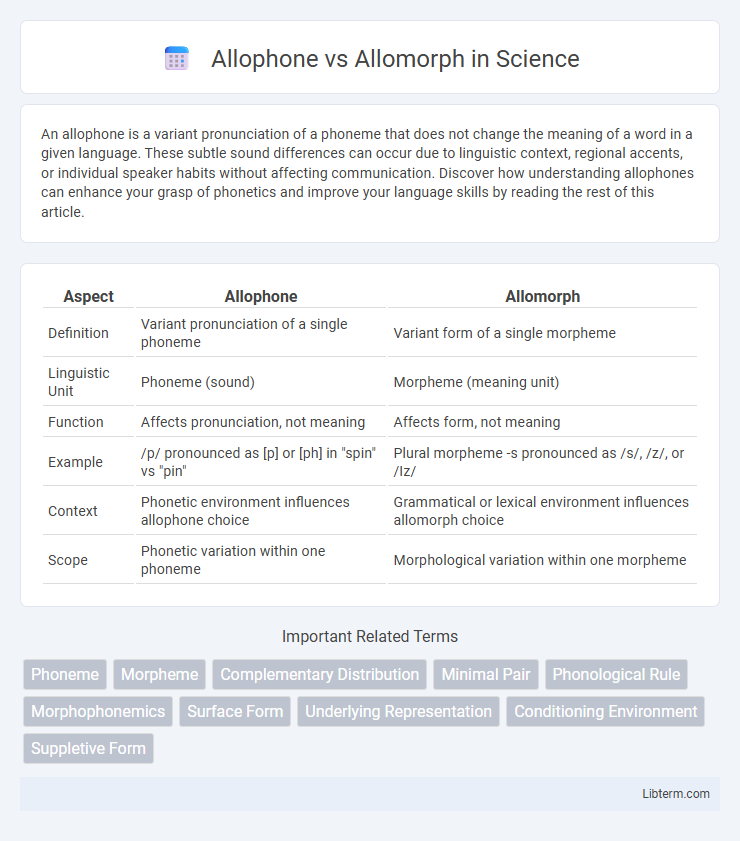An allophone is a variant pronunciation of a phoneme that does not change the meaning of a word in a given language. These subtle sound differences can occur due to linguistic context, regional accents, or individual speaker habits without affecting communication. Discover how understanding allophones can enhance your grasp of phonetics and improve your language skills by reading the rest of this article.
Table of Comparison
| Aspect | Allophone | Allomorph |
|---|---|---|
| Definition | Variant pronunciation of a single phoneme | Variant form of a single morpheme |
| Linguistic Unit | Phoneme (sound) | Morpheme (meaning unit) |
| Function | Affects pronunciation, not meaning | Affects form, not meaning |
| Example | /p/ pronounced as [p] or [ph] in "spin" vs "pin" | Plural morpheme -s pronounced as /s/, /z/, or /Iz/ |
| Context | Phonetic environment influences allophone choice | Grammatical or lexical environment influences allomorph choice |
| Scope | Phonetic variation within one phoneme | Morphological variation within one morpheme |
Introduction to Allophones and Allomorphs
Allophones are variant pronunciations of a single phoneme that do not change word meaning, such as the aspirated [ph] in "pin" versus the unaspirated [p] in "spin." Allomorphs, on the other hand, are different morphological forms of a morpheme that convey the same semantic meaning, like the plural morpheme appearing as /s/, /z/, or /Iz/ in "cats," "dogs," and "horses" respectively. Understanding allophones and allomorphs is essential for analyzing phonological and morphological variation within languages.
Defining Allophones: Variations in Sound
Allophones are distinct variations of a single phoneme that occur in specific phonetic contexts without altering word meaning, such as the aspirated [ph] in "pin" versus the unaspirated [p] in "spin." These variations reflect subtle differences in sound production influenced by surrounding sounds, stress, or position within a word. Understanding allophones is essential in phonetics for analyzing speech patterns and pronunciation diversity within languages.
Understanding Allomorphs: Variations in Form
Allomorphs represent the different phonetic or morphological variations of a single morpheme, reflecting changes in form depending on linguistic context, such as phonological environment or grammatical function. Unlike allophones, which are variations in sound for a single phoneme without altering meaning, allomorphs can affect the structure and meaning of words, as seen in plural suffixes like /s/, /z/, and /Iz/ in English. Understanding allomorphs involves analyzing how morphophonemic rules govern the selection of specific morpheme variants to maintain linguistic coherence and morphological consistency.
Key Differences between Allophones and Allomorphs
Allophones are variations of a single phoneme that do not change the meaning of a word, such as the different pronunciations of the /p/ sound in "spin" and "pin." Allomorphs are variant forms of a morpheme that alter its pronunciation or spelling without changing its underlying meaning, like the plural morpheme in English appearing as /s/, /z/, or /Iz/ in "cats," "dogs," and "horses." The key difference lies in their linguistic level: allophones pertain to phonetics and sound variation, while allomorphs relate to morphology and meaning-bearing units.
Examples of Allophones in Language
Allophones are variant pronunciations of a phoneme that do not change word meaning, such as the aspirated [ph] in "pin" versus the unaspirated [p] in "spin" in English. Another example is the nasalized and non-nasalized vowels in French, where the vowel sound in "bon" [bo] differs from "beau" [bo] but both convey different phonetic realizations. These subtle phonetic variations illustrate how allophones function within the phonological system without altering lexical semantics.
Examples of Allomorphs in Language
Allomorphs are variant forms of a morpheme that differ in pronunciation but share the same meaning, such as the plural morpheme in English appearing as /s/ in "cats," /z/ in "dogs," and /Iz/ in "horses." These phonetic variations depend on the phonological environment, showcasing how morphemes adapt to surrounding sounds. Examples in languages like English and Spanish demonstrate how allomorphs maintain semantic consistency while exhibiting diverse phonetic realizations.
Linguistic Importance of Allophones
Allophones are crucial in phonology as they represent the variant pronunciations of a single phoneme without changing word meaning, demonstrating how speech sounds adapt to different phonetic environments. Unlike allomorphs, which are variations of morphemes affecting meaning or grammatical function, allophones provide insight into subtle sound distinctions that reveal underlying phonemic structures in language. Understanding allophones enhances the analysis of spoken language, aiding in accurate phonetic transcription and improving speech recognition technologies.
Linguistic Significance of Allomorphs
Allomorphs are crucial in morphology as they represent the variant forms of a morpheme, enabling nuanced expression and grammatical precision within languages. They illustrate how phonological, morphological, and contextual factors influence word formation, allowing for the seamless adaptation of morphemes across different linguistic environments. Understanding allomorphs enhances the comprehension of language structure, phonetic variation, and the dynamic processes underlying language change and development.
Allophone and Allomorphs in Phonology and Morphology
Allophones are variant pronunciations of a single phoneme that do not change meaning and occur in specific phonological contexts, exemplified by the aspirated [ph] and unaspirated [p] in English. Allomorphs are different phonetic forms of a morpheme that convey the same semantic function, such as the plural suffixes /-s/, /-z/, and /-Iz/ in English morphology. Phonology studies allophones to understand sound patterns and constraints, while morphology examines allomorphs to analyze morpheme variation in word formation.
Conclusion: Distinguishing Allophones from Allomorphs
Allophones are variations of a single phoneme that do not change word meaning, typically influenced by phonetic context, whereas allomorphs are different morphological forms or variants of a morpheme that can alter meaning or grammatical function. The key distinction lies in phonological variation for allophones versus morphological variation for allomorphs. Understanding this difference clarifies how spoken sounds relate to meaning and structure in language analysis.
Allophone Infographic

 libterm.com
libterm.com